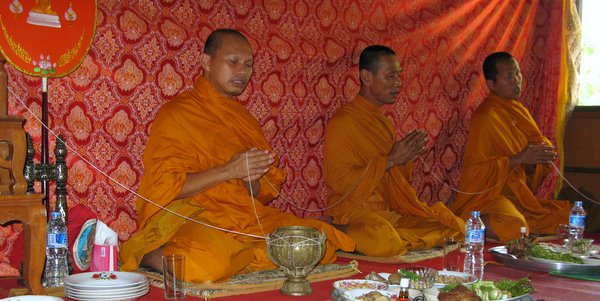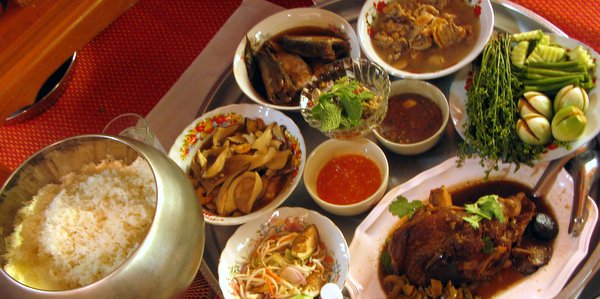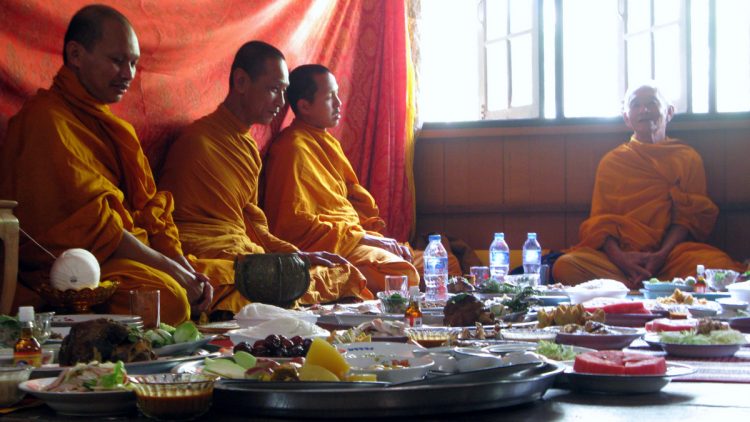Tambun, the act of giving and merit making is an integral part of Buddhist culture.
One of its most widely observed aspects is at home in the ceremony known as tambun baan, at which a group of monks, always in an odd number, visit your house to bestow a blessing.
Such blessings are by no means restricted to just a house, with anything from a car, motorbike or new business also more than eligible.
The Tambun Ceremony
The ceremony, led by the chief monk or ajaarn, starts mid morning, so that everything is finished and the monks fed, before midday, their religious cut-off time for food.
Earlier, one member of the family sets off to fetch them from the temple, while the guests meanwhile split into male and female groupings as they wait. In a traditional Thai house, the women head upstairs and the males remain downstairs. Wherever they are, you’ll hear lots of chatting, joking and catching up on village gossip.
On the monks’ arrival, either squeezed together in the back of a pick up in their distinctive orange robes or disgorging like Chinese boxes from its interior, a hush descends on the gathering.
Seating for a Tambun
In a blink of an eye, the ceremony, with its wonderfully soothing low-level chanting, begins.
The monks are normally cross legged on a slightly raised dais, which you will find in all older houses, with the women before them, kneeling in that seemingly impossible pose of one leg tucked backwards and under.
The men are often just seated in chairs, though like the women, their deference is shown by hands in a praying position in front of the face. That’s not to say that the gossip stops, some of these people have not seen each other for a while, but it drops to a quieter volume.
The String
Part of the ceremony involves string, sai sin. The head monk starts the process of unravelling a ball of it using a special object from the temple, before passing the thread between fingers. He then hands the ball on to the next monk and then the next, until a holy circle is formed.

This might go all around the house and over the owners heads. The chanting gives the thread a sacred quality so that anyone within its circle receives a blessing and protection from bad things.
At the end, one of the monks will leave his partners and move around the congregation sprinkling holy water on the heads of all present. Even the children will stop playing at this point to kneel obediently for their light dousing.
Food Time
Those things over, the serious stuff starts with a feast laid out at the monks feet.
This has been prepared the previous day in a magnificently efficient maelstrom of activity, with cooking undertaken in huge pots over simple gas burners to produce meat, fish and vegetable dishes, alongside delicious desserts (khanom).
The monks, once sated, tend not to hang around but are promptly squeezed once more into the vehicle and delivered back to the wat (temple). The guests meanwhile can then tuck in, helping themselves to two or three servings.

The food will almost always include a curry, a soup, a salad, fresh noodles (khamom jeen) and some raw or steamed vegetables, with various dipping sauces around and about.
It is a no alcohol affair in case you were wondering and charmingly, reminiscent of children’s parties, left-over desserts are quickly packed in little bags for taking home.
After just a few hours, with blessings given, evil warded off, good deeds done, everyone fed and watered and on their way home, the tambun baan is over. Happily, they are a very common part of life, so you won’t have to wait long till the next one.
Back to News from The Islands






